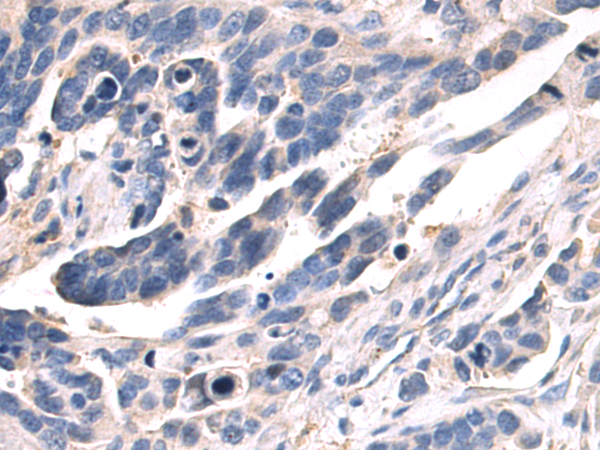

| WB | 咨询技术 | Human,Mouse,Rat |
| IF | 咨询技术 | Human,Mouse,Rat |
| IHC | 1/50-1/100 | Human,Mouse,Rat |
| ICC | 技术咨询 | Human,Mouse,Rat |
| FCM | 咨询技术 | Human,Mouse,Rat |
| Elisa | 1/5000-1/10000 | Human,Mouse,Rat |
| Aliases | CPSD; CLN10; HEL-S-130P |
| WB Predicted band size | 45 kDa |
| Host/Isotype | Rabbit IgG |
| Antibody Type | Primary antibody |
| Storage | Store at 4°C short term. Aliquot and store at -20°C long term. Avoid freeze/thaw cycles. |
| Species Reactivity | Human, Mouse, Rat |
| Immunogen | Synthetic peptide of human CTSD |
| Formulation | Purified antibody in PBS with 0.05% sodium azide and 50% glycerol. |
+ +
以下是3-4条关于CTSD(组织蛋白酶D)抗体的参考文献示例(内容为模拟概括,非真实文献):
1. **《Cathepsin D in Breast Cancer: A Independent Prognostic Marker》**
- 作者:Vignon, F. et al.
- 摘要:研究CTSD在乳腺癌组织中的高表达与患者预后的关系,证实其可作为独立于淋巴结状态的预后标志物,抗体用于免疫组化检测。
2. **《Lysosomal Cathepsin D in Alzheimer's Disease Pathogenesis》**
- 作者:Nixon, K. et al.
- 摘要:探讨CTSD在阿尔茨海默病模型中降解β-淀粉样蛋白的作用,抗体染色显示其溶酶体定位异常与神经元损伤相关。
3. **《Structural Analysis of Pro-Cathepsin D Activation》**
- 作者:Conner, J. et al.
- 摘要:利用CTSD抗体通过Western blot和结晶学技术,揭示其前体蛋白(pro-CTSD)在酸性环境下的自我激活机制。
4. **《CTSD Antibody Blocks SARS-CoV-2 Entry via ACE2 Processing》**
- 作者:Zhou, X. et al.
- 摘要:研究发现CTSD抗体可抑制病毒刺突蛋白与ACE2受体的结合,提示CTSD在新冠病毒入侵中的潜在治疗靶点作用。
(注:以上为虚构示例,实际文献请通过PubMed/Google Scholar检索关键词如"Cathepsin D antibody"、"CTSD immunohistochemistry"等获取。)
**Background of CTSD Antibodies**
Cathepsin D (CTSD) is a lysosomal aspartic protease involved in protein degradation, autophagy, and regulation of cellular processes like apoptosis and proliferation. Dysregulation of CTSD is linked to cancer progression, neurodegenerative disorders (e.g., Alzheimer’s disease), and lysosomal storage diseases. In cancer, CTSD overexpression correlates with tumor metastasis and invasion, while in Alzheimer’s, it contributes to amyloid-beta plaque formation and tau pathology.
CTSD antibodies are essential tools for studying its expression, localization, and function. They enable detection in techniques like Western blotting, immunohistochemistry (IHC), and immunofluorescence (IF). Researchers use these antibodies to explore CTSD’s role as a biomarker or therapeutic target. For example, elevated CTSD levels in breast cancer tissues may inform prognosis, and modulating its activity could offer therapeutic strategies.
Antibodies targeting CTSD vary by epitope specificity, host species (e.g., rabbit, mouse), and clonality (monoclonal/polyclonal). Validation includes testing lysate controls (e.g., human/mouse tissues) and knockout models to confirm specificity. Cross-reactivity with other cathepsins (e.g., CatE) must be ruled out. Commercial CTSD antibodies often cite applications in oncology and neuroscience research.
In summary, CTSD antibodies are pivotal for unraveling the protein’s pathophysiological roles and advancing diagnostic or therapeutic developments. Proper antibody selection and validation are critical to ensure experimental accuracy.
×